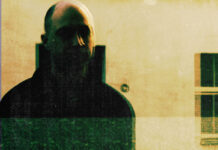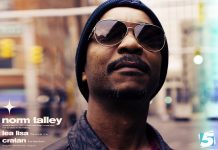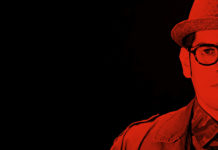Mark Maynard and John Duffy are Pato y Pato, a pair of Detroit musicians who invited me along on a thrilling electronic odyssey with one of the most fascinating, and totally engrossing albums of the year.
Released in late July by This Deadly House, Staples is an LP that almost bursts out of the limitations of the medium, its five tracks advancing in all directions for 54 minutes of dreamy, synthesized ecstasy. To dive in is to lose yourself in compositions without outlines: beats that spread out, colonizing like an airborne virus, riffs that coalesce around a warm ambient hum and dissolve in the rattle of burning electronics. If you like kosmische musik and own a few albums from Phaedra-era Tangerine Dream, Staples is an album that will fit very near to them on your shelf.
In fact, it’s staggering how well Pato y Pato captures the aesthetic of ’70s proto-electronica on Staples. They eschew the use of modern software and computers and the dangers of what Duffy calls “possibility paralysis” in favor of a painstakingly built (and frequently repaired) analog studio. Made outside of the box, the music of Pato y Pato feels alive, it has an air of spontaneity and a sometimes unearthly sound that is, nevertheless, comprehensively human.
5 Mag: The arrangements on Staples made me think of ’70s electronic music – when the music was being put together by strange cabals of rock band guys and guys from an avant-garde classical background. What are your own backgrounds and is this far off?
Mark Maynard: I performed as a percussionist into college and then wrote and toured in a number of unique bands with a wide range of inspiration. I’ve always enjoyed writing drum parts as if they were horns or some other instrument. Sometimes I imagine a scenario where certain sounds or patterns represent a character or a feeling in a storyline. My goal is to lose anything representative of myself in the process, which is silly because someone has to be interpreting something somewhere. Figuring out where that something is coming from and where it is going is the most fun for me.
John Duffy: My background is in guitar, and I’ve been playing in bands and writing music since I was 14. I guess I reached a point where I was looking for a challenge, something that would push me to think about and write music in a new way. Learning about synthesis and electronic music seemed like the perfect opportunity.
What excites me now is how an idea changes as it’s translated from something I hear in my mind to something that turns into a patch and goes through an effects chain. We ran into a number of happy accidents during the recording process, just messing with synth settings. Those are the qualities of the record that I enjoy the most.
 Body Music: Originally published in 5 Mag issue 175 featuring The Revenge, Jimpster, PBR Streetgang, Pato Y Pato & more. Help support 5 Mag by becoming a member for just $1 per issue.
Body Music: Originally published in 5 Mag issue 175 featuring The Revenge, Jimpster, PBR Streetgang, Pato Y Pato & more. Help support 5 Mag by becoming a member for just $1 per issue.
5 Mag: Detroit has a singular reputation as a city with an unparalleled legacy of electronic music. To what degree are you interacting and influenced by the music of the city?
Mark: Detroit is an amazing city for many reasons, but it is wild how many talented folks are making so many unbelievably cool things. It’s electric.
John: You know, I hate to admit it, but I’m not very well versed in Detroit techno. Like, a few years ago I read the liner notes to the Dirtbombs’ Party Store LP and discovered that “Charivari” was actually a cover. Apparently, the original version is a legendary early techno track. For years I thought the Dirtbombs were just trying to go in a new direction or something. Most of the music that really impacted me when I was younger, and that I frequently return to, is Detroit garage and punk. Those sounds, the unique approaches to writing, recording, and performing, are all elements that I bring to this project even though we’re working in a different style.
5 Mag: Staples also had one other difference with most other synth-based records I hear these days. It sounds like it was made in a multi-track studio rather than at home in Ableton. I’ve heard that you didn’t use a computer (in the contemporary laptop/desktop sense) for this. Why?
Mark: It was important to unplug from the computer and play these old keyboards that don’t even have midi. We wanted to feel the edges of the songs, and be able to fuck up a loop and react to it in real time. Feeling the instruments in the room has always been important to us.
John: I think the no computer thing came about for two reasons, really. One, this record is very much an homage to our favorite cosmic and early ambient records of the late ’70s. To be true to the techniques that many of those artists used, we elected to work with mostly older gear.
Two, there’s this weird thing that happens when you’re writing with software instruments, the kind you find packaged with recording software. I think of it as, like, “possibility paralysis,” where you begin a writing session looking to create a dope bass line and three hours later you’re still auditioning guiro samples or whatever. On Staples, most of the bass tracks were made with my Crumar T1, which is a fairly simple Italian synth from the late 70s. Even though the bass section only has five knobs, I can always dial in something I like, and then I’m moving after just a few minutes. No screens, no bugs, no waiting for things to load. You just turn it on and it sounds good. Those are the kinds of instruments I keep around.

5 Mag: I think this is one of the most dense and saturated records of I’ve heard. You often have third, fourth and fifth voices that make kind of spectral appearances from the interaction of two or more tones. What gear did you use on this album? Is this all yours?
Mark: We’re using a few old 70s and 80s synths with a few cool newer pieces. We’ve got some pedals with a couple “less than ideal” drum machines too.
John: Yeah, the gear is ours. Part of the reason this record took a while to produce is that we spent a lot of time tracking down and repairing old instruments. We’d score broken stuff on Craigslist for very little, but then finding skilled folks to repair it was a crapshoot.
Mark’s rig is mostly designed around percussion, pads, and noise textures. Mine is designed around bass and lead tones. I’m using a Crumar T1, a kind of odd-ball Italian synth from the late 70s that has a decent drawbar organ on the right side and a surprisingly original bass synth on the left. I’m also using an early 80s Juno 106 and a recent Moog Minitaur. Those signals all run through a chain of stompboxes, mostly reverbs and delays.
There’s a moment in the opening track, “Secondi,” when you only hear the Juno, and then these waves of drones and bass arps slowly emerge. This drama, this tension between saturation and minimalism, is something we consciously included in the arrangement.
5 Mag: Who is the ideal listener? Do you have one in mind when you make music?
John: We think of the record as a sonic companion to everyday life. Really, its role could be anything. On one hand, you can listen with a pair of hi-fi headphones and have a private, transcendental experience. Or, you could play it through overhead speakers at a grocery store while people shop for cat litter. I think both scenarios have the capacity to be life-changing–and I’m completely serious here. This record can affect listeners wherever they happen to be, and I think that makes it unique and valuable.
5 Mag: You can curate a festival stage, and the only limitation is that the performers need to be alive. Who are you playing with?
Mark: Colleen, Bitchin Bajas, Brian Eno, Suzanne Ciani, Devo, Peter Broderick, Grouper, Faust.
John: Oh, man. I’d love to be part of a festival that features smaller groups and solo performers, folks who riff on minimal stuff, space music, textural and experimental stuff. Definitely Colleen. We really enjoyed her last record. Mountains, for sure. Matmos. Bitchin Bajas. For headliners I’m thinking, like, Manuel Goettsching, Suzanne Ciani, and definitely Marshall Allen and the Sun Ra Arkestra.
5 Mag: How much thought did you give to track order? I sat down to listen to Staples and I have to admit I got lost a couple of times. There are 5 tracks and it comes out to 54 minutes. I believe at about 18 minutes in I thought I had moved on to a totally different record.
Mark: Quite a bit of thought went into the track order. Our goal was to provide a soundtrack to people’s daily travel.
John: I hear that. Our approach to writing and arranging meant that some of the songs have multiple movements, which could read like segues into entirely different songs. In “Reverse Ghost,” the first movement features this moody modulating bass arp and then it evolves through a fog of delay tails into something new: a drone-centered jam that includes the sound of stretching shrinkwrap in the higher register. This movement from one sonic space to another can definitely be disorienting, but, IMO, can also be kinda cool.
5 Mag: Can you perform Staples live? Is it meant to be? How much work goes into it from booking and setting up?
John: Yes, absolutely. We set out to write a record that could be performed live and without the aid of a computer. We’ve been pretty fortunate to work with some great artists and venue managers in Detroit, so booking hasn’t been a big obstacle, but we’re still trying to figure out the most efficient way to transport and assemble the gear. We both drive subcompact hatchbacks, so if any of your readers have any space-saving tips, please get a hold of us.
Mark: When we play live, we like to break it up and throw new ideas in the arrangements. There’s a spontaneity to the live show that can’t be replicated. As for setting up, we can sum up the difficulty in two words: cable management.
5 Mag: Electronic music is constantly being recontextualized. Something that was an avant-garde score in the 1950s became movie sound effects in the 1970s, and something that might have been incidental music in an ’80s action film, for instance, could now be perfectly at home as background music in a coffee shop. Where can you imagine Pato y Pato’s music being heard and appreciated in the future? in both your wildest and most practical dreams?
Mark: Hopefully this is playing on a kid’s “computer” in 2040 and it leads them down a path of discovery, one that takes the many old influences and inspires them to create new ones.
John: I like this question because I’m envisioning, like, a middle-manager with a stack of paperwork in a coffee shop somewhere, just grinding it out while the soundtrack to Escape from New York plays in the background. I would love to go to this place!
This process of reimagining means that my music could live many lives and exist in forms that haven’t been invented yet. So, in my practical dreams, I envision people enjoying the music while moving around–driving, walking, riding the escalator. I hope it assists them as they move through the world. In my wildest dreams–and I echo Sun Ra here–I think music will be used to power spaceships. I want this record to get people to a world where they can live in harmony with each other and with their natural environment. Every time I hit a key on the Juno, I think, This is it. We’re one step closer.
Pato Y Pato’s Staples LP is out now on This Deadly House.


















